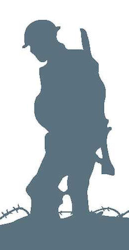Name
Thomas Chandler
1 May 1892
Conflict
First World War
Date of Death / Age
08/10/1916
24
Rank, Service Number & Service Details
Private
250839
London Regiment (Royal Fusiliers)
1st/3rd (City of London) Bn.
Awards: Service Medals/Honour Awards
1914 /15 Star, British War and Victory medals
Cemetery/Memorial: Name/Reference/Country
THIEPVAL MEMORIAL
Pier and Face 9 D and 16 B.
France
Headstone Inscription
N/A
UK & Other Memorials
Hemel Hempstead Town Memorial, St John the Evangelist Memorial Church, Boxmoor, Boxmoor Baptist Church Memorial (now Carey Baptist Church), Marlowes
Pre War
Thomas Chandler was born on 1 May 1892 in Boxmoor, Herts, the son of Susan and Alfred Chandler and one of thirteen children, although three died in childhood.
On the 1901 Census, the family were living at 63 London Road, (Railway Cottage), Boxmoor, where his father was working as a Platelayer on the Railway. He worked for the London and North Western Railway at Boxmoor Station from 25 May 1907, later moving to Berkhamsted station on 31 May 1910 and in 1911 Thomas was working as a Railway Porter for LNWR at Bletchley Station.
Wartime Service
At the outbreak of war Thomas enlisted in London and joined the 3rd (City of London) Battalion, London Regiment (Royal Fusiliers) in September 1914, initially under reg. no. 2802. This was a territorial force with its HQ at 21 Edward Street, Hampstead Road and initially they were mobilised to guard the Basingstoke-Eastleigh railway and prepare for service overseas.
The 2/3rd Battalion, sailed to Malta arriving on 19 April 1915 to man the garrison, allowing the regular army unit to return home for service on the Western Front. They were then sent to Egypt mid September 1915 and onwards to the Dardanelles, landing at Suvla Bay in Gallipoli on 26 September. The Battalion suffered heavy casualties during the next two months, but on 26 November the trenches were flooded and engulfed by snow. The 2/3rd Battalion were the worst hit of any unit with 50 men drowned and another 30 evacuated with frostbite. Although Thomas survived he was admitted to hospital on 26 November suffering from frostbitten feet and was returned to England in January 1916.
After some months of recovery he was sent back to re-join his regiment in France in August and soon saw action at the Battle of Ginchy, followed by the Battle of Flers-Courcelette on 15 September and the Battle of Morval ten days later.
In early October he took part in the Battle of Le Transloy on 7 October 1916 and the initial attack was relatively successful but the following day the attack was held up by heavy enemy machine gun fire and Thomas was one of 47 men listed as missing on 8 October 1916. He was subsequently confirmed killed in action.
He has no known grave and his name is commemorated on the Thiepval Memorial, Belgium.
Additional Information
Brother to Sidney Chandler who was killed in action on 4 August 1916 and is buried at Brown's Road Military Cemetery, Festubert, France. His older brother Joseph served with the Royal Flying Corps and survived the war. His mother received a war gratuity of £9 and pay owing of £2 6s 4d. She also received a pension of £4 2s a week for life in respect of Sidney and Thomas.
Acknowledgments
Brenda Palmer
Jonty Wild, www.dacorumheritage.org.uk, www.hemelatwar.org., www.hemelheroes.com.



